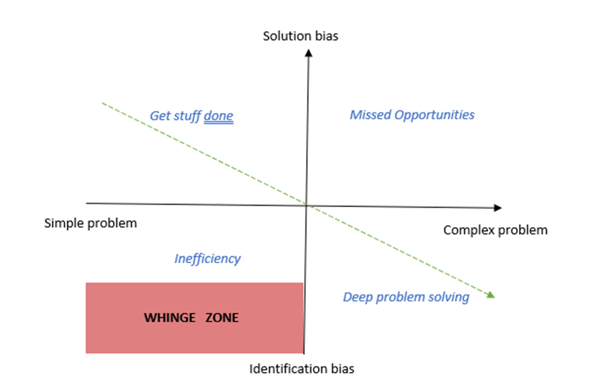Ray Scanlon | 2 March 2023

“Don’t bring me problems, bring me solutions!” We’ve all heard it, and I even remember getting this wise counsel from my own father when I started in the workforce. It comes from a good place, but ultimately it might be doing us more harm than good.
I get it, managers are busy. There are a million competing demands, endless meetings and too many plates spinning in the air; the last thing you want is for a member of your team to add another plate to the pile. So, rather than making it your problem, they should come to you with a solution – genius! This gives you a chance to approve the action rather than coming up with the solution yourself, and at the same time stretches your team member to think differently and get in the mindset of solving problems, not just identifying them.
This advice is not necessarily bad, and it may get some people to think differently about problems they encounter. However, I would question, in the majority of workplace cultures, whether this is the optimal approach.
For the sake of clarity, I’m talking about significant, complex or multi-dimensional challenges here, not simple ones. If your team member walks past the empty reception desk to come and tell you there’s no-one to receive a package from a courier, you have a different problem… (yes, this is an actual, real life example).
So, when faced with a challenge of substance, I’m encouraging you to think about the potential limitations of asking people to only bring you solutions.
The biggest assumption that is made with this approach is that the person who spots a ‘problem’ has the knowledge, expertise, and time to come up with solutions to fix it. If they do not, yet they still try to fix the problem they’ve identified, you will end up with a solution that is less than optimal at best, and at worst something that compounds the problem.
This is an issue that I have seen in many organisations, where the simpler option is just to walk past a problem and not raise it at all. When you use the ‘only bring me solutions’ mantra, you may find that your most competent people (who are also often the busiest), just find it too difficult to spend large amounts of time devising solutions for something there may be no appetite to fix. If you happen to combine this with a culture that is tightly controlled or has a very top-down management style, then you can all-but guarantee there are many, many opportunities for improvement that are being ignored.
The other vital assumption is that your team members are able to see problems from a range of perspectives and will come up with a great solution, not just a quick one. If we are talking about an issue that impacts a range of stakeholders, then the idea that one person may ‘solve’ this in a vacuum is less than ideal. This is where a systems thinking approach needs to be taken, and the problem will almost always be better addressed by a collective than an individual.
If we push each person to solve the problems as they see them, then you may end up with the same problem being worked on by a number of different people at the same time. One core problem may impact several teams, and it is possible that you have one or more people from each of these teams all attempting to fix it. Remembering that it’s very likely that each of these individuals will only view the problem from their perspective, you may end up with several solutions that fix one aspect of the problem, yet create more headaches for everyone else. This is on top of many wasted hours of effort.
If you’re not yet nodding along at this point, it may be useful to have a simple visual view to help you think about when you should push people to bring you solutions, and when you should step in earlier… (and who doesn’t love the simplicity of a 2x2)?

The above graphic is a simple representation of the complexity of the issue, or problem to be solved (x axis), and the bias toward either solving the problem (solution bias), or simply bringing it to attention (identification bias) (y axis). The y axis is what is controllable at both individual and organisational levels.
There are a couple of areas to pay particular attention to. The first one is the ‘Whinge Zone’. We all know people who spend too much time in this space, calling out everything that is wrong with the workplace, yet contributing nothing to bring about any change. The avoidance of this behaviour is part of why the ‘bring me solutions, not problems’ is so appealing. There are few things more frustrating than someone burdening you with a problem that they could easily solve themselves.
The other key focus area is what happens when we over-emphasise solutions to more complex problems, we miss opportunities for impactful change because we have our blinkers on. When we only see improvements as a tick-box activity to be completed, rather than taking the time to meaningfully assess the opportunities the change may bring, it is easy to lose sight of the impacts that change could have.
Now that we’ve brought to light some of the issues with being too solutions-focused, let’s take a look at a few simple steps that can help shift our practice in this area:
If you’re facing a challenging workplace issue or period of change, feel free to get in touch. We can support you through any part of this change process and can work with you to build an environment and culture to support it.